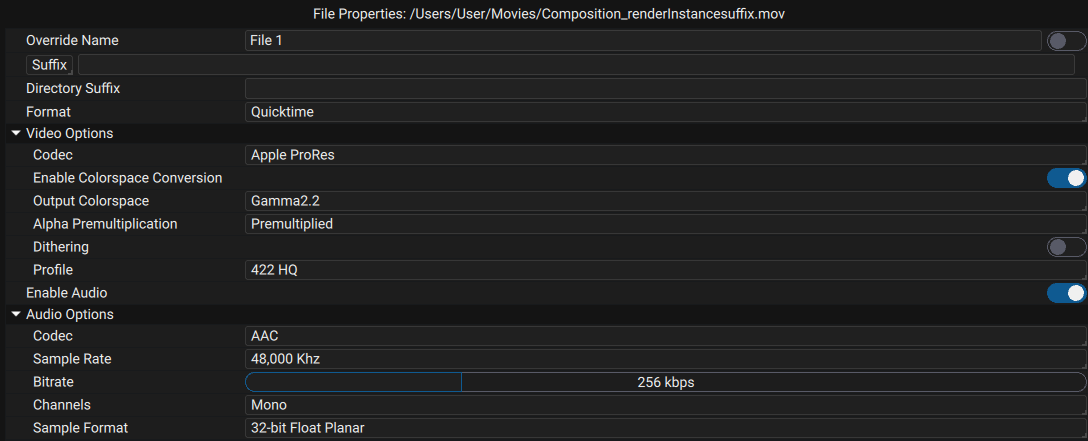File output
A Render File contains all options related to the output file format/codec that will be created.

Video Format
The Format drop-down allow you to choose between video or image formats.
NOTE
When switching to an image format, Autograph will automatically add _#### padding to the Suffix of the file, that will be replaced by the indexing of frame numbers that will produce the image sequence. When rendering to video, make sure no '#' remain in the filename that could be replaced by the frame number.
Image Colorspace
The colorspace options allows you to select the OpenColorIO colorspace used to transfer pixels in the file. Please see the colorspace section for more details.
Video codec
For video rendering, there exist a wild variety of codecs which all have their upside and downside, be it quality, speed of encoding, speed of decoding, size of the compressed video...
All codecs have different options, that will appear under Video Options. Under the Codec dropdown, available video codecs (which vary depending on the Format specified). Note that some codecs are platforms and hardware specific and may not be available, such as AMD AOM, NVIDIA NVENC, Intel QuickSync or Apple VideoToolbox.
To output video files that you plan to re-use as part of an editing workflow, we recommend using the Apple ProRes codec.
To output video files which you plan to use for media playback, we recommand using VP9 or H264. AV1 is supposed to supersede H264 in the near future, but encoders are not yet as optimized in speed.
If you need to export with an alpha channel in your video, we recommend using either Apple ProRes with 4444/4444 XQ profile or VP9 codec.
Alpha Premultiplication
When outputing to a video file, you may select whether you want the Red,Green,Blue channels of the image to be multiplied by the alpha channel or not. Depending on the type of usage you want to do with your media, one or the other may be preferable. Generally for video playback, outputing Premultiplied footage is desired.
Bitdepth
Some image/video codecs offer to control the bitdepth of the image in the file. Note that 32-bit float or 16-bit float bitdepths are High-dynamic-range and allow to preserve negative and overbright values. Selecting 8-bit is fine if you plan to only use your image/video for viewing/playback only but not if its supposed to be color-edited further down the pipeline.
Dithering
For many video/image formats, the dithering parameter is available. Dithering applies random patterns to the image to help reduce banding artifacts on gradient-like patterns when outputing to 8-bit bitdepth.
Audio Options
Audio options allows you to control the codec used to encode the audio as well as the Sample Rate and bitrate which controls the quality/size of the compressed audio.